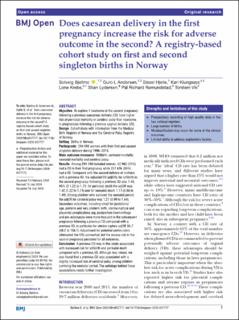| dc.contributor.author | Bjellmo, Solveig | |
| dc.contributor.author | Andersen, Guro Lillemoen | |
| dc.contributor.author | Hjelle, Sissel | |
| dc.contributor.author | Klungsøyr, Kari | |
| dc.contributor.author | Krebs, Lone | |
| dc.contributor.author | Lydersen, Stian | |
| dc.contributor.author | Romundstad, Pål Richard | |
| dc.contributor.author | Vik, Torstein | |
| dc.date.accessioned | 2020-09-28T08:16:13Z | |
| dc.date.available | 2020-09-28T08:16:13Z | |
| dc.date.created | 2020-08-31T13:31:22Z | |
| dc.date.issued | 2020 | |
| dc.identifier.citation | BMJ Open. 2020, 10:e037717 | en_US |
| dc.identifier.issn | 2044-6055 | |
| dc.identifier.uri | https://hdl.handle.net/11250/2679863 | |
| dc.description.abstract | Objective To explore if newborns in the second pregnancy following a previous caesarean delivery (CD) have higher risk of perinatal mortality or cerebral palsy than newborns in pregnancies following a previous vaginal delivery (VD).
Design Cohort study with information from the Medical Birth Registry of Norway and the Cerebral Palsy Registry of Norway.
Setting Births in Norway.
Participants 294 598 women with their first and second singleton delivery during 1996–2015.
Main outcome measures Stillbirth, perinatal mortality, neonatal mortality and cerebral palsy.
Results Among 294 598 included women, 42 962 (15%) had a CD in their first pregnancy while 251 636 (85%) had a VD. Compared with the second delivery of mothers with a previous VD, the adjusted OR (adjOR), for stillbirth in the second pregnancy following a previous CD was 1.45, 95% CI 1.22 to 1.73; for perinatal death the adjOR was 1.42 (1.22 to 1.73) and for neonatal death 1.13 (0.86 to 1.49). Among children who survived the neonatal period, the adjOR for cerebral palsy was 1.27 (0.99 to 1.64). Secondary outcomes, including small for gestational age, preterm and very preterm birth, uterine rupture and placental complications (eg, postpartum haemorrhage and pre-eclampsia) were more frequent in the subsequent pregnancy following a previous CD compared with a previous VD, in particular for uterine rupture adjOR 86.7 (48.2 to 156.1). Adjustment for potential confounders attenuated the ORs somewhat, but the excess risk in the second pregnancy persisted for all outcomes.
Conclusion A previous CD was in this study associated with increased risk for stillbirth and perinatal death compared with a previous VD. Although less robust, we also found that a previous CD was associated with a slightly increased risk of cerebral palsy among children surviving the neonatal period. The aetiology behind these associations needs further investigation. | en_US |
| dc.language.iso | eng | en_US |
| dc.publisher | BMJ Publishing Group | en_US |
| dc.rights | Navngivelse-Ikkekommersiell 4.0 Internasjonal | * |
| dc.rights.uri | http://creativecommons.org/licenses/by-nc/4.0/deed.no | * |
| dc.title | Does caesarean delivery in the first pregnancy increase the risk for adverse outcome in the second? A registry-based cohort study on first and second singleton births in Norway | en_US |
| dc.type | Peer reviewed | en_US |
| dc.type | Journal article | en_US |
| dc.description.version | publishedVersion | en_US |
| dc.source.volume | 10 | en_US |
| dc.source.journal | BMJ Open | en_US |
| dc.source.issue | 8 | en_US |
| dc.identifier.doi | 10.1136/bmjopen-2020-037717 | |
| dc.identifier.cristin | 1826239 | |
| dc.description.localcode | This is an open access article distributed in accordance with the Creative Commons Attribution Non Commercial (CC BY-NC 4.0) license, which permits others to distribute, remix, adapt, build upon this work non-commercially, and license their derivative works on different terms, provided the original work is properly cited, appropriate credit is given, any changes made indicated, and the use is non-commercial. See: http://creativecommons.org/licenses/by-nc/4.0/. | en_US |
| cristin.ispublished | true | |
| cristin.fulltext | original | |
| cristin.qualitycode | 1 | |

